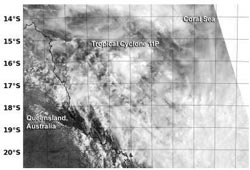NASA-NOAA satellite sees Tropical Cyclone 11P headed for Queensland

NASA-NOAA's Suomi NPP satellite captured this image of Tropical Cyclone 11P on Jan. 28 at 04:19 UTC, revealing a more rounded circulation than the previous day, and bands of thunderstorms over the storm's southern semi-circle.<br><br>Credit: NASA/NOAA/NRL
The VIIRS instrument aboard Suomi NPP captured an image of 11P on January 28 at 04:19 UTC/Jan. 27 at 11:19 p.m. EST. The image showed a more rounded circulation than the previous day, and bands of thunderstorms over the storm's southern semi-circle.
The Australian Bureau of Meteorology or ABM has issued a Cyclone Warning for coastal and island communities from Cairns to St Lawrence, including Townsville and Mackay. A Cyclone Watch remained in effect for communities through the eastern interior including Charters Towers and Moranbah. For updated warnings and watches, please visit ABM's website at: http://www.bom.gov.au
11P was passing near Willis Island, and according to the Joint Typhoon Warning Center or JTWC, the radar there indicated that the low-level center was better organized, but bands of thunderstorms appeared fragmented and loosely organized.
At 1500 UTC/10 a.m. EST on January 29, Tropical Cyclone 11P had maximum sustained winds near 35 knots/40 mph/62 kph. It was centered 247 nautical miles/284.2 miles/457.5 km east of Cairns, Australia, near 17.1 south and 149.8 east. Tropical Cyclone 11P is moving to the southwest at 6 knots/6.9 mph/11.1 kph.
The JTWC expects 11P to strengthen to 50 knots before making landfall. The JTWC forecast calls for landfall around 0000 UTC on January 31/7 p.m. EST on January 30 and the ABM forecast calls for 11P to cross the Queensland coast between Lucinda and Proserpine on January 31, Friday morning.
Media Contact
More Information:
http://www.nasa.govAll latest news from the category: Earth Sciences
Earth Sciences (also referred to as Geosciences), which deals with basic issues surrounding our planet, plays a vital role in the area of energy and raw materials supply.
Earth Sciences comprises subjects such as geology, geography, geological informatics, paleontology, mineralogy, petrography, crystallography, geophysics, geodesy, glaciology, cartography, photogrammetry, meteorology and seismology, early-warning systems, earthquake research and polar research.
Newest articles

Superradiant atoms could push the boundaries of how precisely time can be measured
Superradiant atoms can help us measure time more precisely than ever. In a new study, researchers from the University of Copenhagen present a new method for measuring the time interval,…

Ion thermoelectric conversion devices for near room temperature
The electrode sheet of the thermoelectric device consists of ionic hydrogel, which is sandwiched between the electrodes to form, and the Prussian blue on the electrode undergoes a redox reaction…

Zap Energy achieves 37-million-degree temperatures in a compact device
New publication reports record electron temperatures for a small-scale, sheared-flow-stabilized Z-pinch fusion device. In the nine decades since humans first produced fusion reactions, only a few fusion technologies have demonstrated…





















